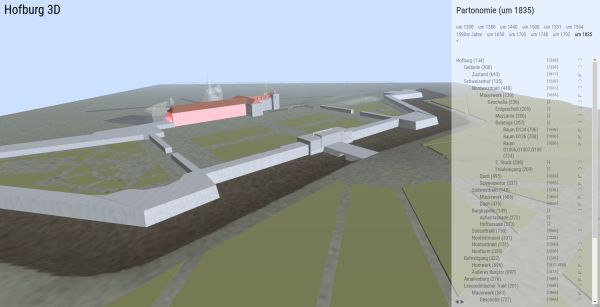Gabriel WURZER1 | Christoph HOFFMANN2 | Elmar SCHMIDINGER3 | Herbert WITTINE3 | Richard KURDIOVSKY2 | Julia FORSTER1 | Andreas VOIGT1
(1TU Wien, 2ÖAW, 3Independent, Vienna, Austria)
Keywords: Partonomy, 4D Visualization, Vienna Hofburg
Abstract:
4D visualizations of heritage commonly use time-attributed geometry in order to show the progression of building history through successive phases; however, modelling such a progression is hard geometrically and semantically because a building undergoes constant change (i.e. additions, removals, merge and splits of model parts, potentially at a very small level) and furthermore the notion of a “building part” itself is fuzzy – a room which was known as „First antichambre“ at a certain time, might belong to a completely different in a next phase due to remodelling works – even if the function and naming of the room did not change. Decomposing a building into a strict hierarchy of parts-within-parts is thus not possible. The authors have instead opted to use a partonomy – i.e. a structure describing part-whole relationships in an abstract way, where time spans, concrete geometry and documentation may be added as an attribute afterwards. Using this concept, it is possible to inherit information from parent parts; it also makes modelling of building parts having a fuzzy definition easier. However, it would be unfair to say that this data structure solves every problem associated with building history, as was found out during practical work concerning the 4D visualization of the Vienna Hofburg. To share our insights also with view to other projects that might benefit from using partonomies is our goal in this paper. In more detail, we will present our prototype visualization and take a look behind the scenes so as to show how the visualized data is fetched from the partonomy. We will also be describing possible ways of using inheritance for attributing information, which can help structure information more efficiently. We are sure that the contribution will serve a wider audience occupied with modelling heritage as a reference.
Relevance for the conference: Partonomies are highly relevant for representing building history, which is why we wish to summarize lessons learned when applying them for the Vienna Hofburg “Quellenspeicher” project
Relevance for the session: Representing time in a partonomy offers significant advantage due to abstraction and inheritance among represented objects
Innovation: The contribution lies in applying partonomies to a concrete project, and sharing the lessons learned in that context with the audience
References:
• Friedrichs K., Münster S., Kröber C., Bruschke J. (2018) Creating Suitable Tools for Art and Architectural Research with Historic Media Repositories. In: Münster S., Friedrichs K., Niebling F., Seidel-Grzesińska A. (eds) Digital Research and Education in Architectural Heritage. UHDL 2017, DECH 2017. Communications in Computer and Information Science, vol 817. Springer, Cham;
• Richard Kurdiovsky, Günther Buchinger, Renate Holzschuh-Hofer, Markus Jeitler, Herbert Karner, Anna Mader-Kratky, Paul Mitchell, Anna Stuhlpfarrer & Werner Telesko (2015) Legitimacy through History and Architecture. The Vienna Hofburg as Dynastic Hub and Seat of Government between Tradition and Innovation, The Court Historian, 20:2, 109-136, DOI: 10.1179/1462971215Z.00000000017



